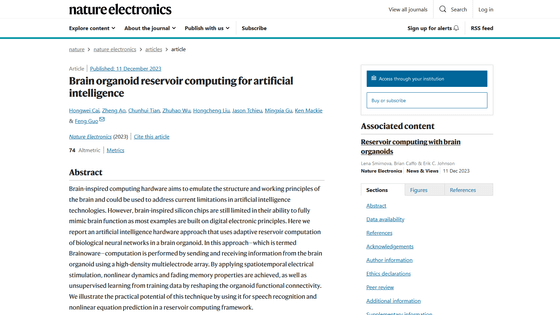Succeeded in building a computer using cultured human brain tissue, also compatible with Japanese speech recognition

Indiana University has succeeded in building a setup called ' Brainoware ' in which
Brain organoid reservoir computing for artificial intelligence | Nature Electronics
https://www.nature.com/articles/s41928-023-01069-w

Scientists Built a Functional Computer With Human Brain Tissue : ScienceAlert
It is known that the human brain has approximately 86 billion neurons and trillions of synapses . Each neuron is connected to up to 10,000 other neurons that communicate with each other. In recent years, scientists and engineers have been working on the design and development of hardware and algorithms inspired by the structure and workings of the brain, and are attempting to build computers based on advanced biological systems.
Guo's research team connected brain organoids grown in the laboratory with electrodes using a type of artificial neural network called ' reservoir computing .' Electrical signals sent through the electrodes send information to the brain organoids, which process the information and output calculation results in the form of neural activity data. The research team calls the series of systems 'Brainoware.'

When the research team applied an electrical signal to Brainoware, it responded to the signal and output neural activity data. The research team said, ``The results of this experiment demonstrate the possibility that Brainoware can actually process information and perform computational tasks without human supervision.''
Below is an example of one of the brain organoids used in Brainoware and its neural activity scanned.

To further demonstrate the usefulness of BrainoWare, the research team used 240 audio clips recorded by eight subjects pronouncing Japanese vowels. We conducted a test to see if we could identify voices. BrainoWare processes the audio clips that have been converted into electrical signals and outputs the signals. When analyzing the output signal using AI, Brainoware succeeded in identifying the speaker with approximately 78% accuracy despite only two days of training. On the other hand, Mr. Guo points out that it is less accurate than a pure hardware computer running on AI.
Still, Guo says, ``The results of this experiment are the first demonstration of using brain organoids for computing. We were able to confirm the potential of brain organoids in future biocomputing.''
'As systems using brain organoids become more sophisticated, a myriad of ethical questions will arise,' said Lena Smirnova and Brian Kafo of Johns Hopkins University. 'It will be critical to keep ethical considerations in mind,' he said, adding, 'This research provides fundamental insights into the mechanisms of learning, neurodevelopment, and the cognitive impact of neurodegenerative diseases.' 'It has great potential to yield new results, and may also be useful in developing models for testing new treatments.'
Related Posts:
in Science, Posted by log1r_ut







